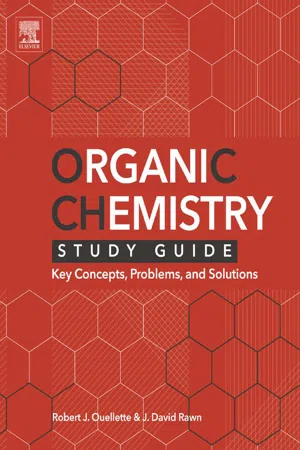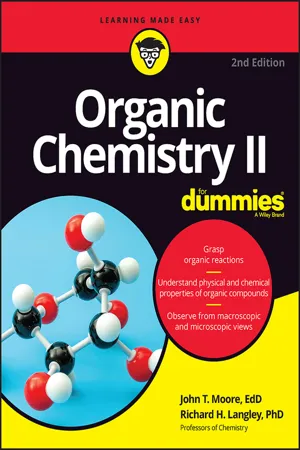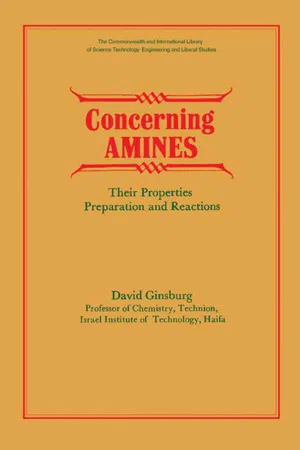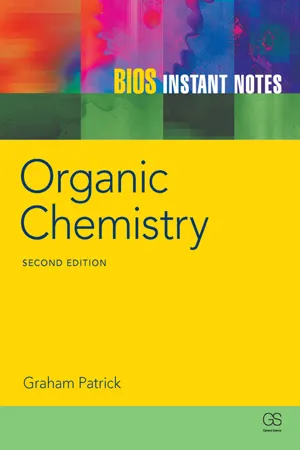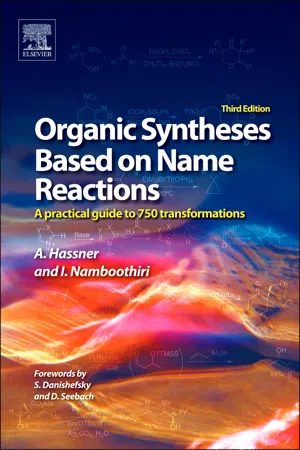Chemistry
Gabriel Synthesis
Gabriel Synthesis is a method used to prepare primary amines from potassium phthalimide and alkyl halides. The reaction involves the formation of an intermediate, which is then hydrolyzed to yield the desired primary amine. This method is widely used in organic synthesis.
Written by Perlego with AI-assistance
Related key terms
5 Key excerpts on "Gabriel Synthesis"
- eBook - ePub
Organic Chemistry Study Guide
Key Concepts, Problems, and Solutions
- Robert J. Ouellette, J. David Rawn(Authors)
- 2014(Publication Date)
- Elsevier(Publisher)
Ammonia and amines are nucleophiles, and they displace halide ion from haloalkanes to give more highly substituted amines. However, multiple substitution reactions are possible since each product successively acts as a nucleophile. Therefore, the reaction is not synthetically useful in the synthesis of a single product.The Gabriel Synthesis is used to convert a haloalkane into an amine in which the amino group replaces the halogen. However, only primary amines can be prepared because of competing elimination reactions in one of the steps. The steps required are:1. Convert phthalimide into its conjugate base2. Add a primary haloalkane to form an alkylated phthalimide3. Release the amine using either strong base or hydrazine23.8 Synthesis of Amines by Reduction
Any functional group containing nitrogen in a higher oxidation state can be reduced to give an amine, which contains nitrogen in its lowest oxidation state. These include azides, imines, nitriles, amides, and nitro compounds.Azides are prepared by the SN 2 displacement of a halide from a haloalkane by the azide ion. Reduction of the azide by either hydrogen and platinum as catalyst, or lithium aluminum hydride in ether gives a primary amine.The double bond of an imine can be reduced by hydrogen and Raney nickel, or by a metal hydride. Sodium borohydride reduces imines, so lithium aluminum hydride is seldom used. The reductive amination reaction forms an imine, by reaction of a primary amine with either an aldehyde or ketone, which is reduced immediately in the reaction by hydrogen in the presence of a nickel catalyst. Secondary amines also react by formation of an iminium ion followed by reduction.Nitriles are reduced to primary amines using lithium aluminum hydride. The nitrile can be made by displacement of a halide ion from a haloalkane by cyanide ion. This method allows the formation of primary amines having one additional carbon atom.Reduction of amides using lithium aluminum hydride is the most versatile way of producing amines. Amides are easily prepared by reaction of an acyl chloride and an amine. - eBook - ePub
- John T. Moore, Richard H. Langley(Authors)
- 2023(Publication Date)
- For Dummies(Publisher)
N 2 mechanism, so it works best on primary alkyl halides and less well on secondary alkyl halides. It doesn’t work on tertiary alkyl halides or aryl halides.Reduction preparations
We can reduce a number of nitrogen species to an amine. In the following sections we take a look at some of the methods that can be used.FIGURE 13-13: The preparation of potassium phthalimide from phthalimide and potassium hydroxide.FIGURE 13-14: Using the Gabriel Synthesis to produce an amine.Nitro reductions
Organic nitro compounds, RNO2 , can be reduced to amines. The R may be either alkyl or aryl. Aromatic nitro compounds are easy to prepare and reduce. Their preparation utilizes a mixture of nitric acid and sulfuric acid to nitrate the aromatic ring. (However, multiple nitrations may occur, potentially causing problems.) The nitro group can be reduced with a number of simple methods, including catalytic hydrogenation of the nitro compound or the reaction of the nitro compound with a metal (Fe, Zn, or Sn) in the presence of hydrochloric acid followed by the addition of excess base. The generic symbol for all of these reductions is [H]. An example of the formation of a nitro compound followed by reduction is shown in Figure 13-15 .FIGURE 13-15: The preparation of a nitro compound followed by reduction to an amine.Reductive amination
A number of organic species, including amides, oximes, and nitriles, undergo reductive amination, a variety of reduction reactions that produce amines. In general, these processes involve imines, R=N-R, or related species. Reduction processes include hydrogenation using Raney nickel as the catalyst (for nitriles), the reaction with sodium/EtOH (for oximes), and the use of lithium aluminum hydride, LiAlH4 (for amides or nitriles). Figure 13-16 - eBook - ePub
Concerning Amines
Their Properties, Preparation and Reactions
- David Ginsburg, Robert Robinson(Authors)
- 2014(Publication Date)
- Pergamon(Publisher)
This type of reaction is a fairly general one. There is usually sufficient spread in boiling points between the primary, secondary and tertiary amines to permit their separation through fractional distillation. As stated for methylamine, the primary amine may, in general, be obtained in reasonable yield if excess ammonia is used. The reaction may usually be stopped also at the tertiary amine stage. Secondary amines are best prepared by other methods which will be discussed below. Quaternary ammonium salts are always made by alkylation of tertiary amines.There is, however, a serious limitation to the above synthetic method. It works well with primary halides, RCH2 X; usually the chloride or bromide is used. It works fairly well with many secondary halides, RR’CHX but the reaction is useless where tertiary halides are concerned. The reason for this is that ammonia and amines are bases and may therefore bring about an elimination reaction as well as the desired substitution. The latter reaction predominates in primary halides. The elimination reaction is:We have stated before that the industrial amination of chlorobenzene with ammonia at high pressure and temperature is a nucleophilic substitution at an unsaturated carbon:(See, however, discussion on 153 –6 .)This is a much more difficult reaction to carry out than in the respective o- or p -nitro substituted chlorobenzenes. The following reactions proceed with much greater ease because electron-withdrawal from the ring by the nitro group aids nucleophilic substitution at the halogen-substituted carbon atom.ALKYLATION OF THE PHTHALIMIDE ANION (Gabriel Synthesis)
Gabriel devised a method for the preparation of primary amines unaccompanied by impurities of secondary or tertiary amines.Phthalimide has a nitrogen atom flanked by two carbonyl groups. Such an arrangement of carbonyl groups about the nitrogen atom causes the compounds involved to be slightly acidic. This influence is due to the fact that both the neutral phthalimide molecule and its conjugate base (its anion, obtained by removal of a proton) are resonance stabilized. - eBook - ePub
- Graham Patrick(Author)
- 2004(Publication Date)
- Taylor & Francis(Publisher)
Figure 3 ).A third possible method is to react an alkyl halide with ammonia, but this is less satisfactory since over-alkylation is possible (see below). The reaction of an aldehyde with Figure 1. Synthesis of a primary amine from an alkyl halide via an alkyl azide. Figure 2. lonization of phthalimide. Figure 3. Gabriel Synthesis of primary amines.ammonia by reductive amination is a fourth method of obtaining primary amines (see next section ).Alkylation of alkylamines
It is possible to convert primary and secondary amines to secondary and tertiary amines respectively by alkylation with alkyl halides by the SN 2 reaction (Section L6 ). However, over-alkylation can be a problem and better methods of amine synthesis are available.Reductive amination is a more controlled method of adding an extra alkyl group to an alkylamine (Figure 4 ). Primary and secondary alkylamines can be treated with a ketone or an aldehyde in the presence of a reducing agent called sodium cyanoborohydride. The alkylamine reacts with the carbonyl compound by nucleophilic addition followed by elimination to give an imine or an iminium ion (Section J6 ) which is immediately reduced by sodium cyanoborohydride to give the final amine. Overall, this is the equivalent of adding one extra alkyl group to the amine. Therefore, primary amines are converted to secondary amines and secondary amines are converted to tertiary amine. The reaction is also suitable for the synthesis of primary amines if ammonia is used instead of an alkylamine. The reaction goes through an imine intermediate if ammonia or a primary amine is used (Figure 4a ). When a secondary amine is used, an iminium ion intermediate is involved (Figure 4b - eBook - ePub
Organic Syntheses Based on Name Reactions
A Practical Guide to Over 800 Transformations
- Alfred Hassner, Irishi Namboothiri(Authors)
- 2011(Publication Date)
- Elsevier(Publisher)
GABRIEL–HEINE Aziridine Isomerization to GUY–LEMAIRE–GUETTE Halogenation ReagentThis article contains brief overviews, mechanisms and practical details for organic synthesis named reactions and processes beginning with the letter ‘G’. Reactions included in this section are: GABRIEL–HEINE Aziridine Isomerization; GABRIEL Amine Synthesis; GABRIEL–COLMAN Phthalimide Rearrangement; GAREGG–SAMUELSON Diol Elimination; GARIGIPATI Amidine Synthesis; GARNER Chiral Aldehyde; GARST–SPENCER Furan Annulation; GASSMAN Oxindole Synthesis; GASTALDI Pyrazine Synthesis; GATTERMANN–KOCH Aromatic Carbonylation; GEWALD 2-Aminoheterocycles Synthesis; GHOSEZ Cyclobutanone Synthesis; GIESE Free Radical CC Coupling; GILMAN Organocuprate Reagents; GILMAN–SPEETER β-Lactam Synthesis; GILMAN–VAN ESS Ketone Synthesis; GINGRAS Aryl-Sn Reagent; GIRARD Hydrazine Reagents; GLASER–SONDHEIMER Acetylene Coupling; GOLD Aminomethylating Agent; GOMBERG–BACHMANN Arylation via Diazonium Salts; GOULD–JACOBS Quinolone Synthesis; GRAHAM Diazirine Synthesis; GRANACHER Aldehyde Homologation; GRIECO Olefination of Alcohols; GRIECO Ether Protection Reagent; GRIESS Deamination; GRIGNARD Reagents; GROB Fragmentation; GROEBKE–BLACKBURN–BIENAYME Aminoimidazole Synthesis; GROVENSTEIN—ZIMMERMANN Carbanion Rearrangement; GRUBBS Olefin Metathesis; GUILLEMONAT–SHARPLESS Allylic Oxidation; GUY–LEMAIRE–GUETTE Halogenation ReagentGABRIEL–HEINE Aziridine Isomerization
Isomerization of N-acyl, N-double bond aziridines by acids, nucleophilic reagents or pyrolysis to thiazolines (5 → 6), imidazolines (3 → 4, 7 → 8), oxazolines, triazolines (9 → 10).1-(N-p-Nitrophenylbenzimidoyl)aziridine (3).3 To a stirred mixture of aziridine 2 (1.1 g, 25.5 mmol) and Et3 N (5.05 g, 50 mmol) in PhH (70 mL) was added in 1 h a solution of N-p-nitrophenylbenzimidoyl chloride 1 (6.52 g, 11.6 mmol). After 1 h stirring at 20 °C, filtration of Et3 N·HCl and evaporation of the filtrate afforded 6.6 g (95%) of crude 3, mp 116–120 °C; recrystallized from i
Index pages curate the most relevant extracts from our library of academic textbooks. They’ve been created using an in-house natural language model (NLM), each adding context and meaning to key research topics.
